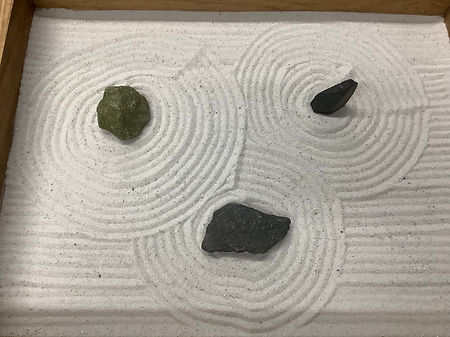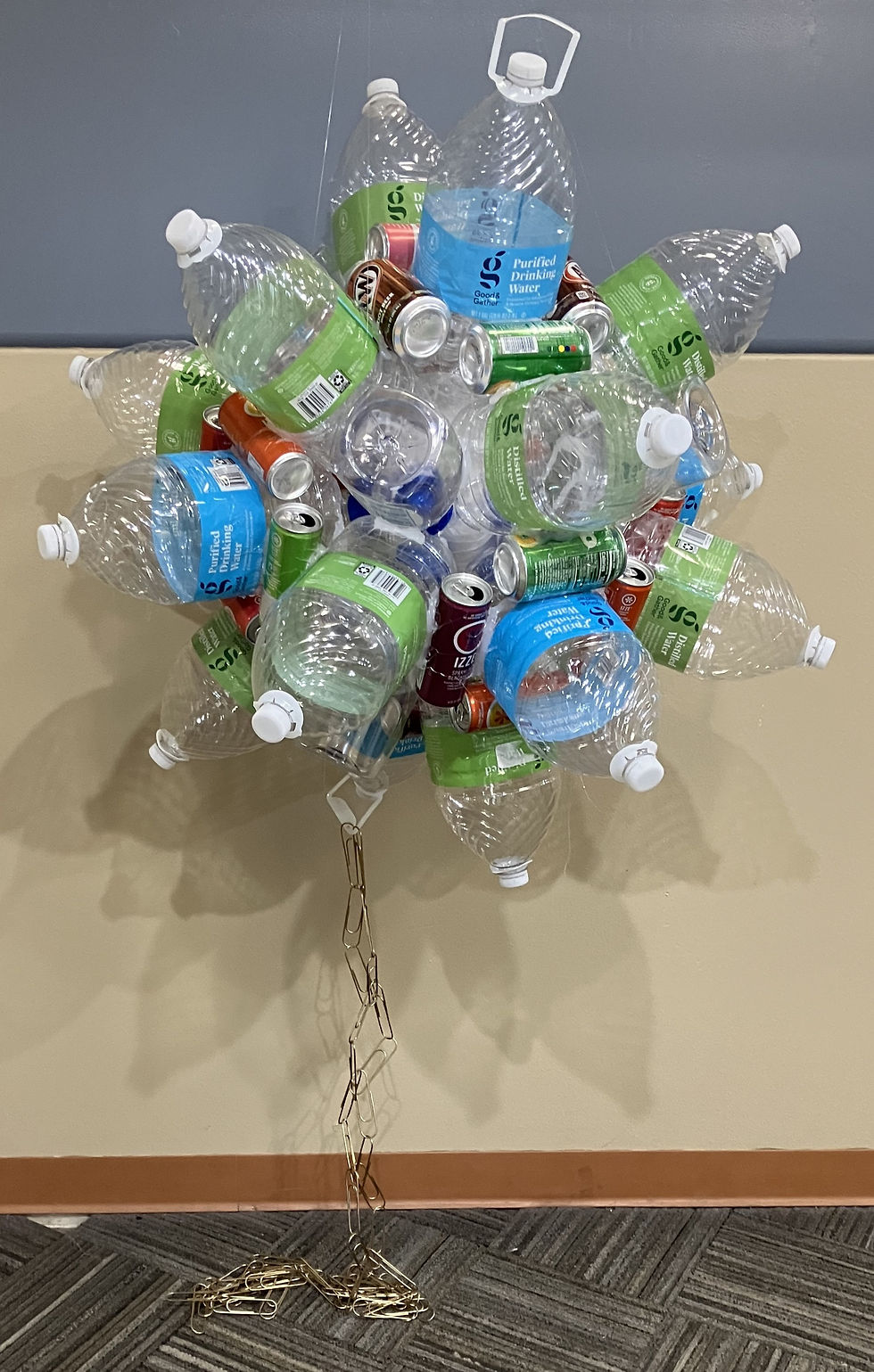
Exhibition Gallery
The Exhibition is one of the three exam components for the IB Art Visual course. It is the culmination of the students’ IB Art experience, showcasing a selection of their best works in the form of a curated show. Students also articulate and defend their artistic intentions and goals for the show in a written curatorial rationale. Each selected artwork is supported by a concise explanation of the artistic intention for the artwork.
This page showcases my works created in my junior and senior years.
Echoes of Extinction
Clay Sculpture
17” x 8” x 9”
This clay sculpture memorializes the recently extinct Scioto Madtom, a victim of pollution and habitat destruction. Shaped as a functional vessel, the fish’s upward-facing mouth cradles a cascading plant, symbolizing both loss and fragile hope for renewal. The contrast between clay’s permanence and water’s vulnerability urges viewers to reflect on humanity’s impact on aquatic ecosystems and the urgency of conservation efforts before more species vanish.

.jpg)

Breathe
Colored Pencils on Paper
10” x 8”
Inspired by Jordan Robins’ bioluminescent algae photography, this seascape captures the calming rhythm of ocean waves. Smooth textures and layered details create a natural flow, while white highlights depict the brightest areas of bioluminescence. The waves radiate outward, evoking the sensation of breathing, as if worries dissolve into the water’s gentle pulse, offering a moment of serenity.
.png)
.png)
.png)

Water Is Life
Colored Pencils on Black & White Paper
11.5” x 8.25”
This drawing contrasts water’s essential role in sustaining life with the consequences of its absence. A tilapia is depicted in two states—one half skeletal and decayed, the other vibrant and thriving—symbolizing the impact of pollution and scarcity. The stark contrast between monochrome and color emphasizes water’s irreplaceable role in survival. This piece urges viewers to reflect on their responsibility to protect water before more ecosystems collapse.


In a Box
Clay Sculpture
9.5” x 8.5” x 6.25”
This clay sculpture explores water’s resistance to confinement. A rigid box represents imposed control, yet water breaks through, defying restriction. Inspired by minimalist sculpture and Tom Friedman’s conceptual works, the piece highlights water’s persistence and freedom. Blue glaze emphasizes its organic movement, reinforcing the idea that water cannot be contained—it will always find a way forward.





The Great Cleanse
Linocut Print
Each Print is 4” x 6”
In this series of linocut prints, the biblical tale of Noah’s Ark is used to explore water’s dual nature—destructive in the deluge, yet life-affirming in the aftermath. Inspired by Katsushika Hokusai’s “Thirty-six Views of Mount Fuji”, the prints contrast dynamic curves for turbulent waters and serene lines for calm, reflecting Noah's Ark's tale of destruction and renewal on a postcard scale for intimate reflection on humanity’s fragility against nature’s power.

Under the Monster
Linocut Print; Ink on Paper
10” x 8”
This relief print reimagines the biblical story of Noah’s Ark to highlight water’s destructive power. Inspired by Katsushika Hokusai’s “Under the Wave Off Kanagawa”, it captures a towering wave poised to consume the Ark. The exaggerated curves and dynamic tension of the composition emphasize humanity’s vulnerability against nature’s unstoppable fury, inviting intimate reflection on the overwhelming and indifferent power of the sea and the natural world.
.jpg)
.jpg)
.jpg)

Flow
Wood, Sand, Rocks, Hand Crafted Wooden Rakes
24” x 18” x 4”
Inspired by Japanese karesansui (rock) gardens, “Flow” explores water’s calming and introspective qualities through sand, rocks, and traditional raking patterns. The flowing lines evoke movement and impermanence, reflecting water’s meditative nature. By condensing these elements into a confined space, the work invites viewers to engage in quiet reflection, mirroring the tranquility and balance found in nature.


Vulnerable
Found Objects
36” x 36” x 36”
Inspired by Sayaka Ganz’s “Blue”, this sculpture resembles a naval mine, constructed from everyday waste to symbolize the hidden yet devastating threat of water pollution. The mine’s form warns of the hidden dangers plastics and metals pose to aquatic ecosystems and human health. By using discarded materials and pollutants, this piece urges viewers to reflect on their role in pollution and advocate for actions that mitigate the pollution of our precious water resources.




Exhibition Arrangement & Curatorial Rationale
Curatorial Rationale
The Curatorial Rationale is a part of the Exhibition component of IB Art Visual course requirements. It is used to articulate and justify my artistic intentions and goals for the show.
My exhibition explores the multifaceted and often contradictory nature of water—its ability to calm and destroy, resist and seek freedom, sustain life and suffer from human misuse. Water becomes not just a natural element but a symbolic medium to explore themes of control, vulnerability, and transformation. Each work contributes to a broader investigation of how water reflects human values, behaviors, and consequences.
Inspired by Katsushika Hokusai’s 36 Views of Mount Fuji, I was drawn to the stylized lines, scale, and visual rhythm in his prints. His depiction of water as both beautiful and threatening shaped how I approached composition. I also incorporated Japanese Zen garden philosophy, where water is abstractly represented through sand raking, symbolizing reflection, impermanence, and repetition. These influences merged with contemporary environmental concerns like pollution and extinction, shaping my conceptual development.
I aimed to present water as both physical and metaphorical—revealing the relationship between humanity and nature through formal choices, symbolic contrast, and layered meaning. Throughout the exhibition, I used color and material choices to support mood. Cool tones evoke serenity or melancholy; stark monochrome enhances dramatic contrast. The principles of balance, contrast, rhythm, and emphasis helped unify the exhibition as a whole.
I selected works that reflect water’s opposing characteristics—tranquility and chaos, life and loss—while intentionally varying media and form. The exhibition includes two-dimensional works (printmaking and drawing) and three-dimensional works (ceramics and mixed media), allowing me to explore water’s complexity from different perspectives. My linocut prints of Noah’s Ark and a stylized wave use exaggerated curvature, diagonal motion, and high tonal contrast to emphasize water’s destructive energy. Inspired by Hokusai’s formal techniques, these prints use positive and negative space to guide the viewer’s eye and create dynamic tension.
In contrast, my Japanese karesansui (rock) garden employs minimalism, repetition, and implied lines to evoke serenity and balance. The use of natural materials like sand and stone, along with symmetrical arrangements, reinforces the meditative qualities of water without depicting it directly. The ceramic sculpture of the extinct Scioto Madtom fish was created with exaggerated scale and organic forms to amplify its presence. A trailing plant emerges from its mouth, acting as a symbolic motif of growth and loss. The glossy glaze enhances texture and contrast, highlighting the tension between life and absence. In my ceramic cube, water bursts from rigid geometric confinement. The piece uses slab-building techniques and expressive glaze to contrast structured and fluid forms. It emphasizes water’s resistance to restriction, symbolizing its resilience despite human control. Grouped together, my bioluminescent wave drawing, fish sculpture, and fish drawing reflect on aquatic life and ecological vulnerability. Their shared cool palettes offer a sense of calm reflection.
The arrangement of artworks guides viewers through a conceptual and emotional progression. It opens with the fish sculpture, fish print, and bioluminescent wave drawing, grouped to emphasize aquatic life and water’s fragility. Their cool tones, varied textures, and subtle spatial separation evoke disconnection, serving as a quiet introduction to ecological vulnerability.
Progressing through the narrow path, the viewer encounters the ceramic cube, displayed alone. Its placement as a midpoint highlights its conceptual role: water escaping containment. The contrast between its rigid form and expressive glaze draws focus, symbolizing both release and defiance. As a transitional piece, it marks a shift from reflection to confrontation. The linocut prints, grouped vertically, build a cohesive visual narrative through the repeated formal elements of line, color, and the recurring subject of water. I used simplified and colorful images to show water’s destructive and renewing qualities to reach a broader audience.
At the top of the staircase—the final point in the exhibition—the Zen garden and plastic naval mine face the viewer as a looming conclusion. Their proximity creates a powerful contrast between water’s meditative symbolism and the threat of human exploitation. The natural materials of the karesansui garden—wood, sand, and stones—oppose the plastic bottles and metal cans in the naval mine, creating a chilling contrast and commentary on water’s current role as humanity's polluted commodity.
Each curatorial decision—from grouping and pacing to spatial placement—was intentional, guiding the viewer through water’s emotional and symbolic journey. As viewers ascend physically, they also move conceptually, ending not in resolution, but in critical reflection.

